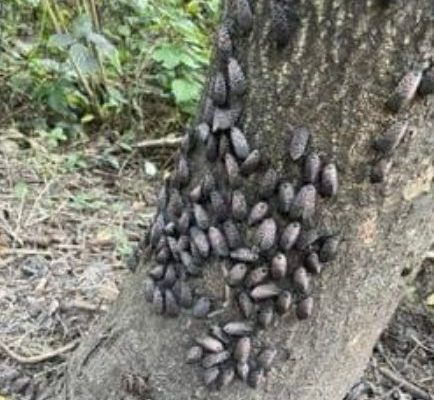The spotted lanternfly appears to be harmless but if you see one of these highly invasive bugs, show it no mercy.
Keep reading to learn about the bug that you need to kill!
If you look up lanternfly on social media, you’ll find several posts of people sharing their kills of these bugs, native to China, that start mating in late summer.
“Run over by my car because apparently this lanternfly is a horribly invasive species and everyone should be murdering them,” writes New Jersey’s social media influencer Marques Brownlee.
Another user shares his triumph over his recent kills: “Out for a walk, saw a spotted lanternfly. STOMP. Yay! 10 feet further on, ooh, another one. STOMP. Yay!”
Attaching a photo of a mass of nymphs on a tree, he then continues writing, “A few feet further on… Oh no.”
Spotted lanternfly
The spotted lanternfly, or Lycorma delicatula, is an invasive species that poses significant ecological and economic threats.
Since it first traveled from China to Pennsylvania in 2014, it’s spread to parts of North America, feeding on plants like fruit trees (apple, cherry or grape) and hardwoods like maple or walnut, killing them over time.
They also produce a sticky substance called honeydew, which can lead to the growth of sooty mold and further damage plants.
What do they look like?
In the late summer to fall, about 30 to 50 eggs are laid in a mass which is covered in a waxy, mud-like coating. These masses are initially light gray to brownish and become darker over time.
Once they hatch, the nymphs are black with white spots, and as they grow older, they turn a bright reddish color with black borders and white dots.
When they reach maturity, lanternflies are about one inch long, with grayish forewings marked with black spots. Their underwings are red with black spots that are bordered with white.
They feed on plant sap by piercing plant tissues with their needle-like mouthparts. This feeding weakens plants and can lead to their death, especially in high numbers.
Impact on Ecosystems and Agriculture
- Economic Damage: The spotted lanternfly can cause severe damage to fruit crops such as grapes, apples, and peaches, as well as hardwoods. The feeding activity weakens plants and can lead to significant yield losses.
- Ecological Impact: Beyond agriculture, the lanternfly can disrupt local ecosystems. By feeding on a variety of plants, it can alter plant communities and affect the animals that depend on those plants.
Scrape and crush
Controlling and killing spotted lanternflies involves a combination of methods, given their ability to quickly spread and damage plants.
Here are some effective approaches to manage and eliminate these pests:
- Egg Masses: Scrape off egg masses from surfaces like tree trunks, fences, or any outdoor objects. Next, place the mass in a sealed bag with alcohol or sanitizer and discard them in the trash.
- Nymphs and Adults: Crush nymphs and adults when spotted. This can be done by hand, or foot, or smash it with a tool like a broom. Be sure to wear gloves to avoid direct contact.
If you’re in an area under quarantine for spotted lanternflies, follow all regulations to prevent spreading them to other areas.
Also, report sightings to local authorities or agricultural departments to aid in broader control efforts.
Please let us know about your experiences with these pesky creatures! And make sure you share this story so others know how destructive lanternflies are to our environment!




